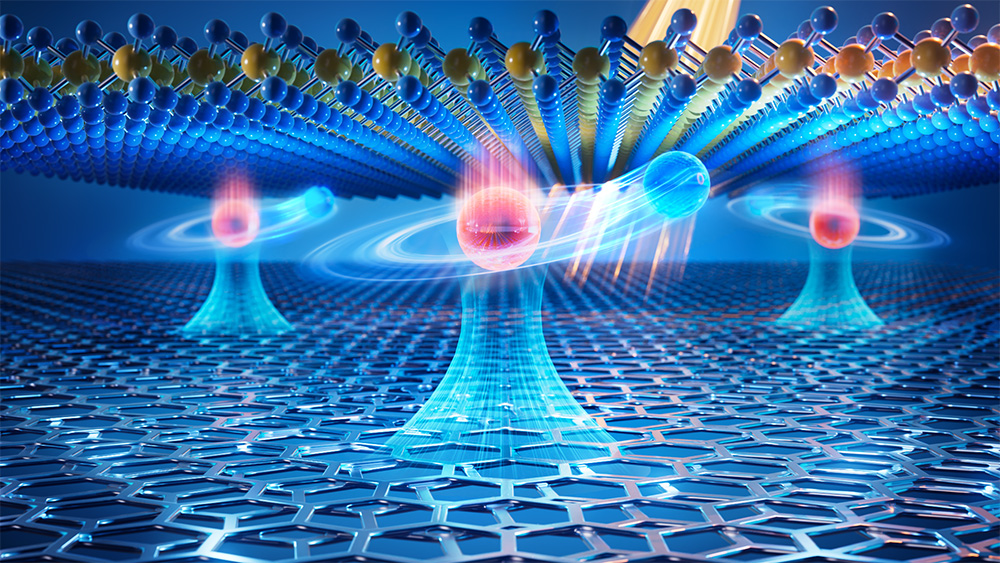Scientists Discover Rydberg Moiré Excitons
Date:03-07-2023 Print
The Rydberg state is widely present in a variety of physical platforms such as atoms, molecules, and solids. In particular, the Rydberg excitons are highly excited Coulomb bound states of electron-hole pairs, first discovered in the semiconductor material Cu2O in the 1950s. Their solid-state nature, in conjunction with the large dipole moments, strong mutual interactions, and significantly enhanced interactions with the surroundings, holds promises for a wide range of applications in sensing, quantum optics, and quantum simulation. However, comparing with their atomic counterparts Rydberg atoms that have been widely explored in recent years, the exploitation of Rydberg excitons is far from reaching their full potential. One of the main obstacles lies on the difficulty to realize efficient trapping and manipulation of the Rydberg excitons. Lately, the rise of two-dimensional moiré superlattices with highly tunable periodic potentials provides a possible pathway.
In recent years, researchers from the Institute of Physics, Chinese Academy of Sciences including Dr. XU Yang and his collaborators have been devoted to exploring the application of Rydberg excitons in two-dimensional (2D) semiconducting transition metal dichalcogenides (such as WSe2). They have developed a new Rydberg sensing technique, which utilizes the sensitivity to the dielectric environment of the Rydberg excitons for detecting the exotic phases in a nearby 2D electronic system. For example, using this technique, they have been able to reveal the abundance of correlated insulating states at fractional fillings in a 2D moiré heterobilayer platform (WSe2/WS2). Recently, they have collaborated with a team led by Dr. YUAN Shengjun from Wuhan University and reported the observation of Rydberg moiré excitons, which are moiré trapped Rydberg excitons in monolayer semiconductor WSe2 adjacent to small-angle twisted bilayer graphene (TBG).
Through low-temperature optical spectroscopy measurements, they first find the Rydberg moiré excitons manifest as multiple energy splittings, pronounced red shift, and narrowed linewidth in the reflectance spectra. By comparing with numerical calculations performed by the group from Wuhan University, they attribute these observations to the spatially varying charge distribution in TBG, which creates a periodic potential landscape (so-called moiré potential) for interacting with the Rydberg excitons. The strong confinement of the Rydberg exciton is achieved through the largely unequal interlayer interactions for the constituent electron and hole of the Rydberg exciton by the spatially accumulated charges centered in the AA-stacked regions of TBG. The Rydberg moiré excitons hence realize electron-hole separation and exhibits the character of long-lived charge-transfer excitons.
They demonstrate a novel method of manipulating Rydberg excitons that can be hardly achieved in bulk semiconductors. The long-wavelength (tens of nm) moiré superlattice here renders an analogue to the optical lattices created by a standing-wave laser beam or arrays of optical tweezers for Rydberg atom trapping. The tunable moiré wavelengths, the in-situ electrostatic gating, and longer lifetime ensure great controllability of the system, with a strong light-matter interaction for convenient optical excitation and readout. Our study could bring up new opportunities for the next-step realization of the Rydberg-Rydberg interactions and coherent control of the Rydberg states for further application in quantum information processing and quantum computation.

Figure 1. A cartoon showing the Rydberg moiré excitons in the WSe2/TBG heterostructure.

Figure 2. Spectroscopic evidence of the Rydberg moiré exciton formation in WSe2 adjacent to 0.6° TBG and numerical calculations of the spatial charge distribution in TBG at different doping levels.

Figure 3. Twist angle dependences and crossover to the strong-coupling regime.
This study entitled "Observation of Rydberg moiré excitons" was published on Science.
This work was supported by the National Key R&D Program of China, the National Natural Science Foundation of China, the Strategic Priority Research Program of the Chinese Academy of Sciences, and the Synergetic Extreme Condition User Facility.
Contact:
Institute of Physics
XU Yang
Email: yang.xu@iphy.ac.cn
Key words: Rydberg excitons, moiré superlattice, 2D semiconductor, twisted bilayer graphene
Abstract:
Rydberg excitons, the solid-state counterparts of Rydberg atoms, have sparked considerable interest with regard to the harnessing of their quantum application potentials, but realizing their spatial confinement and manipulation poses a major challenge. Lately, the rise of two-dimensional moiré superlattices with highly tunable periodic potentials provides a possible pathway. Here, we experimentally demonstrate this capability through the spectroscopic evidence of Rydberg moiré excitons (XRM), which are moiré-trapped Rydberg excitons in monolayer semiconductor tungsten diselenide adjacent to twisted bilayer graphene. In the strong coupling regime, the XRM manifest as multiple energy splittings, pronounced red shift, and narrowed linewidth in the reflectance spectra, highlighting their charge-transfer character wherein electron–hole separation is enforced by strongly asymmetric interlayer Coulomb interactions. Our findings establish the excitonic Rydberg states as candidates for exploitation in quantum technologies.

